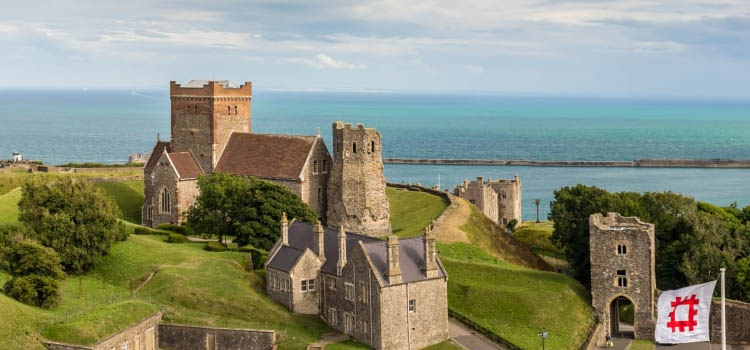A 360º View of Dover Castle
The Dover Castle is an example of English medieval architecture. Known as the “key to England” it is located in Dover, county of Kent, in England and was founded in the 12th century.
History
Dover is a strategic location of vital importance throughout English history, already in the Bronze Age and before the Roman invasion in 43 AD, a fortification existed as seen in the traces of the pre-existing foundation. After the Roman conquest, they built a 24m high lighthouse that still exists although it is not in operation. With the founding of the Cinque Ports, Dover becomes the most important fortification in the area, with fundamental roles after the Battle of Hastings, named by William the Conqueror (winner in that battle) as the undefeated fortress.
Building
Dover Castle is England’s star attraction, built by Henry II in the 12th century. It is spread over three levels including a banquet room, kitchen, pantry and bedroom and has been beautifully done up in vibrant colors to evoke the times and life of King Henry II. Unlike any other castle in England, Dover has played an important role in the history of Great Britain through 950 years. Dover Castle is amazing because:
- It was the first Norman castle, established in 1066.
- It resisted the French siege in 1216.
- It resisted the French invasion during the Napoleonic wars of the 1800’s.
- It was even used in WWII World as the basis for one of Britain’s greatest moments: the rescue of Dunkirk.
- Parts of the castle were also used as a hospital during World War II.
Built in 1941-2 as a medical bandage station for wounded troops, today’s visitors can enjoy the sounds, smells and atmosphere of the WWII underground hospital with its theater of operations. The incredible strategic location of the castle is one of the reasons why it is so important in English history, being recognized by William the Conqueror, Henry II in 1770 and even by the British army in World War I and World War II. Dover Castle is huge, standing about 620 meters between its furthest spur and the Dover cliffs. The entire site is wrapped in a thick wall built in the 12th century, which is divided by two entrances on its eastern side, the first break from being Canon’s gateway, an entrance for cars; and the second break from being Constable’s front door, which is primarily a pedestrian access point.
Nowadays
Today, Dover Castle is managed by the English Heritage and is open to the public, offering a fascinating insight into the history of the fortress. Visitors can explore the medieval castle and its underground tunnels, numerous exhibits are displayed which immerse them in the lives of the ancient inhabitants of Dover Castle and tell its fascinating story. Much of this castle is very well preserved and has been restored to its original state to show what it would have been like at different points in history, offering an authentic experience. Fans of ancient history can also see a very well preserved Roman lighthouse. Dover will surprise you with a lot of city attractions.
Dover Castle in the Two World Wars
By 1905 advances in technology made it possible for the coastal artillery around the harbor to be controlled from a cliff-edge central. His position in command led the Admiral to create a signal station on top of it in 1914, from which the Navy controlled the movement of all ships in and out of the port. The Napoleonic tunnels were reused in World War II and made a great contribution to British history.
From 1939 Dover Castle was the command center that controlled naval operations in the Channel. It was from here that in 1940 Vice Admiral Bertram Ramsay organized the extraordinary evacuation of the British troops from Dunkirk. In the next few years the tunnels were greatly expanded to become a combined hospital and large headquarters, responsible for guarding the Strait of Dover and participating in the preparation for the invasion of Europe in 1944. Later, during the Cold War, this network of tunnels became the secret location of the government of Great Britain, in the event of a possible nuclear attack.


